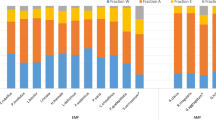Abstract
In laboratory studies, water-soluble extracts of the litter of four shrub and three conifer species had variable effects on the growth of four species of ectomycorrhizal fungi. In general, low concentrations (parts per thousand) stimulated fungal growth; while, high concentrations (parts per hundred and parts per ten) either stimulated growth, inhibited growth, or had no effect, depending on both fungal and litter species. In greenhouse studies, litter applied to the surface of a sand-soil mixture reduced the formation ofRhizopogon sp. on Douglas-fir seedlings. Allelochemicals in the litter may inhibit seedling growth and suppress fungai growth and root colonization in the field, thus explaining the failures of reforestation by conifer species in disturbed sites.
Similar content being viewed by others
References
Alavarez, I.F., Rowney, D.L., andCobb, F.W., Jr. 1979. Mycorrhizae and growth of white fir seedlings in mineral soil with and without organic layers in a California forest.Can. J. For. Res. 9:311–315.
Bevege, D.I. 1968. Inhibition of seedling hoop pine (Araucaria cunninghamia) on forest soils by phytotoxic substances from the root zones ofPinus, Araucaris, andFlindersia.Plant Soil 29:263–273.
DeBell, D.S. 1970. Phytotoxins: New problems in forestry.J. For. 68:335–337.
Fisher, R.F. 1980. Allelopathy: A potential cause of regeneration failure.J. For. 78:346–350.
Handley, W.R.C. 1963. Mycorrhizal associations andCalluna heathland afforestation.Bull. For. Commun., London. No. 36.
Hillis, W.E., Ishikura, N., andFoster, R.C. 1968. The role of extractives in the formation of ectotrophic mycorrhizae.Phytochemistry 7:409–410.
Marx, D.H. 1969. The influence of ectotrophic mycorrhizal fungi on the resistance of pine roots to pathogenic infections. I. Antagonism of mycorrhizal fungi to root pathogenic fungi and soil bacteria.Phytopathology 55:153–163.
McClure, P.R., Gross, H.D., andJackson, W.A. 1978. Phosphate absorption by soybean varieties: The influence of ferulic acid.Can. J. Bot. 56:764–767.
Melin, E. 1963. Some effects of forest tree roots on mycorrhizal basidiomycetes, pp. 125–145, P.S. Nutman and B. Mosse, (eds). Symbiotic associations. Cambridge University Press, New York.
Nykvist, N. 1963. Leaching and decomposition of water-soluble organic substances from different types of leaf and needle litter.Stud. For. Suec. 3:1–29.
Olsen, R.A., Odham, G., andLindeberg, G. 1971. Aromatic substances in leaves ofPopulus tremula as inhibitors of mycorrhizal fungi.Physiol. Plant 25:122–129.
Parke, J.L. 1982. Factors affecting the inoculum potential of VA and ectomycorrhizal fungi in forest soils and southwest Oregon and northern California. Unpublished PhD thesis. Oregon State University Department of Botany and Plant Pathology.
Persidsky, D.J., Lowenstein, H., andWilde, S.A. 1965. Effect of extracts of prairie soils and prairie grass root on the respiration of ectotrophic mycorrhizae.Agron. J. 57:311–312.
Rice, E.L. 1979. Allelopathy—An update.Bot. Rev. 45(1):15–109.
Robinson, R.K. 1972. The production by roots ofCalluna vulgaris of a factor inhibitory to growth of some mycorrhizal fungi.J. Ecol. 60:219–224.
Schoeneberger, M.M., andPerry, D.A. 1982. The effect of site disturbances on growth and ectomycorrhizae on Douglas-fir and western hemlock seedlings: A greenhouse bioassay.Can. J. For. Res. 12:343–353.
Stewart, R.E. 1975. Allelopathic potential of western bracken.J. Chem. Ecol. 1:161–169.
Tan, K.H., andNopamornbodi, V. 1979. Fulvic acid and the growth of the ectomycorrhizal fungus,Pisolithus tinctorius.Soil Biol. Biochem. 11:651–653.
Voight, G.K. 1971. Mycorrhizae and nutrient mobilization, pp. 122–131,in E. Hacskaylo (ed.). Mycorrhizae. Proceedings of the First North American Conference on Mycorrhizae. USDA Forest Service Misc. Pub. 1189.
Whitehead, D.C., Dibb, H., andHartley, R.D. 1981. Extradant pH and the release of phenolic compounds from soils, plant roots and leaf litter.Soil Biol. Biochem. 13:343–348.
Author information
Authors and Affiliations
Rights and permissions
About this article
Cite this article
Rose, S.L., Perry, D.A., Pilz, D. et al. Allelopathic effects of litter on the growth and colonization of mycorrhizal fungi. J Chem Ecol 9, 1153–1162 (1983). https://doi.org/10.1007/BF00982218
Received:
Revised:
Issue Date:
DOI: https://doi.org/10.1007/BF00982218




